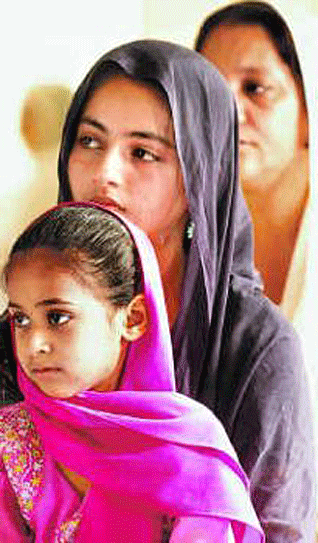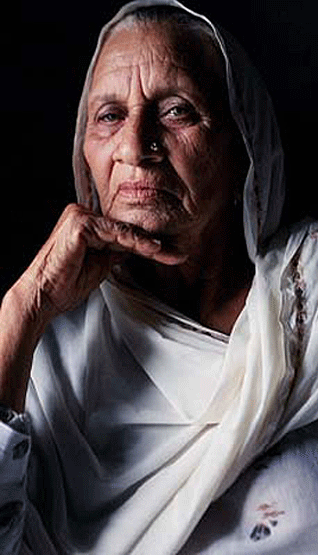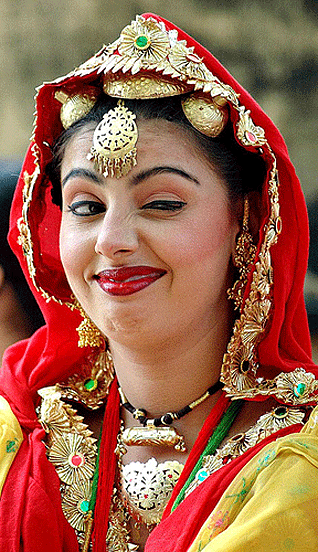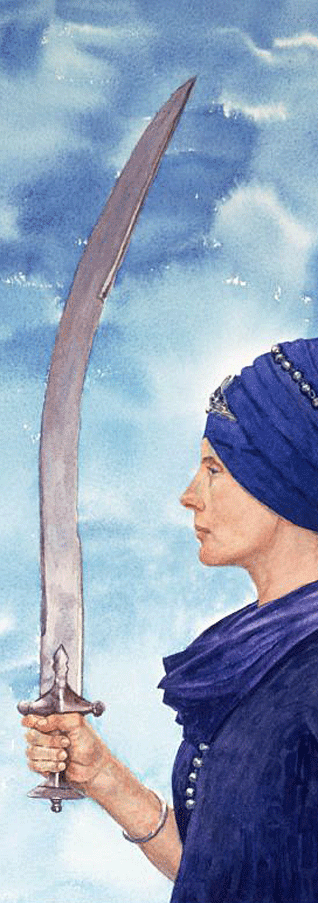
Above: photo, courtesy Mahesh Harilal. Below: first from bottom - detail from painting by Guru Kirin Kaur. Second from bottom - from photo by Raminder Pal Singh. Thumbnail photo: courtesy - Solarider.



Columnists
History and Her-Story
by I.J. SINGH
Our local gurdwara has spawned a nascent and energetic Sikh Women's Association. Recently, they hosted a program to celebrate the life of Mata Sahib Kaur.
For those on unfamiliar territory, Sahib Kaur, nee Sahib Devan, had a brief but telling part to play when the first amrit ceremony was held by Guru Gobind Rai in 1699. This event marked the beginning of the Khalsa institution.
In a dramatic gesture, the Guru had demanded a head from the followers. After considerable reluctance, one man offered his head. The Guru repeated his call, brandishing a blood-stained sword until he had five volunteers. He then appeared with the five, alive and well, nobly attired, and proclaimed them the first Khalsa. He then knelt before them and asked the Five to initiate him in turn. He then became Gobind Singh.
From this dramatic beginning, a nation was created; these were the final touches to the message of Guru Nanak that matured under the tutelage of the nine Gurus that followed him. Gobind Singh was the tenth in that line. And, at this rite in 1699, Sahib Devan added sugar puffs (patashas) to the bowl of amrit.
From that day, initiated Sikhs (Khalsa) look to Guru Gobind Singh as their spiritual father, and Sahib Kaur as their spiritual mother. (Mata is an honorific indicating "mother".)
When I got the call to speak about her, sure enough, like any "ten o'clock scholar", I hurried to my modest library for a spot of research. Can you imagine my surprise at the paucity of available information? The classic reference work in Punjabi on Sikhism - Bhai Kahan Singh Nabha's Mahaan Kosh - carried barely a three-inch column on her. The other authoritative work, edited by Dr. Harbans Singh, the 4-volume Encyclopaedia of Sikhism in English, had just one column (half a page) entry.
We have the names of her parents, but not her date of birth. The two sources even clash on when she appeared at Anandpur where the institution of the Khalsa was founded - in 1699 or 1700. If the later date is correct, as suggested by the Encyclopaedia, what does it do our belief that she added patashas to the amrit at the First Ceremony?
She outlived Guru Gobind Singh, and communicated with the far-flung Sikh community via letters and directives. She died sometime between 1734, the date on her last missive to Sikhs, and 1747. A memorial to her stands at Bala Sahib Gurdwara in New Delhi.
She may have spent her last years in Delhi, which was, at that time, under rulers absolutely and despotically against Sikhs. And that makes me wonder!
My purpose here is not to cavil at historical details; it is to point out that every year we unfailingly honor this woman as the mother of the Khalsa, and yet her known bio is so skimpy.
We all live and die. What lessons can we draw? How little do we know of our pioneering women? How do I look at her and others like her?
The magic, the meaning and the measure of a life - indeed of history - are found not in the celebration of an individual or an event, but in the interpretation.
History is a narrative. What does it tell us about the time that Guru Nanak trod this earth, particularly about the place of women?
In the traditional Hindu society, scriptures were not open to women, female infanticide was not uncommon, and widow remarriage was not permitted. It was best for a widow to commit sati and perish by submitting to being burnt at the pyre of her dead husband.
Society operated by the edicts of the Hindu law-giver, Manu. The essence of his teachings on women can be summarized in one sentence: a woman is subject to her father's will before marriage, to her husband's thereafter.
There were only two major religions in India at that time: Hinduism and Islam. The lives of Muslim women were not much better, except that Islam was then the politically dominant religion in India.
We all know that Sikhism's founder, Guru Nanak, spoke eloquently about women. He clearly rejected the restricted space of women in Indian life. Kabir, too, rhetorically asked, "If circumcision makes a Muslim, what are we to do with a woman? Won't she remain a non-Muslim?"
Yes, one can preach a message of gender equality, one can exhort people to think, and one can even legislate equal rights, but it is like taking a horse to water: there is no easy way to make it drink.
To make reality of a recommendation or even of legislation requires a revolutionary change in the mindset. A cultural paradigm shift is necessary. Such a life-altering modification does not happen in an hour, a day, a year or even a lifetime.
I offer some unrelated, but not irrelevant, examples to drive the point home. In the United States, women won the right to vote only in 1920, but now, 87 years later, we are still debating if the country is ready for a woman president. This country lived through the painful reality of a civil war in 1860, but a hundred years later in 1965, a voting rights bill was necessary. And racial discrimination still continues to fester.
Obviously, the laws change many minds; that's their intent and that's why they are enacted. But many of us continue to cling to outmoded views.
Nevertheless, Guru Nanak's message did resonate with people. Under the tutelage of the third Guru, Amardas, the heinous custom of sati was rejected, widows remarried instead of being banished from life, and many women were appointed to positions of authority to preach the message of Nanak. But you should note that this occurred three generations after Guru Nanak.
Paradigm shift occurs, but slowly and haltingly.
Sikh history and culture have effectively sidelined and marginalized women. Look at how little we know of our pioneering women. Our culture also sidelines young people, but I save that for another time.
We have effectively written young people and women out of our own history.
I offer you another example, but from the time of Guru Gobind Singh, the Tenth Master.
History tells us that at a difficult time, in December 1705, in the midst of a battle against overwhelming odds, forty Sikhs chose to walk out and desert their Guru. History also tells us that when they reached their homes, one woman - Mai Bhago, aka Bhag Kaur - shamed them and challenged them by drawing a line in the sand. To a man, they rose to the occasion. She led the band of forty back to the Guru and into battle, where they each earned martyrdom. They have etched a place in our hearts, and for the past three hundred years, Sikhs worldwide have remembered them every day in their daily prayers as the Blessed Forty.
But what do we know of their intrepid leader, Mai Bhago? Not much more than the two lines I have penned here.
Clearly, she was no ordinary housewife. She must have been adept at the use of weapons, excellent on horseback, and unmatched in leadership skills. The forty battle-hardened veterans would not have followed a lesser leader. And these are not skills that one can learn overnight.
Mai Bhago's story tells me that in the more than two centuries from Guru Nanak to Guru Gobind Singh, the roles of Sikh women had changed. They had become equal in many ways. There was a meritocracy at play here, not gender-determined destiny.
Yet, what does history tell us about their personal stories? Close to zilch. And they lived nine generations after Guru Nanak, until the further liberation on the First Vaisakhi Day.
When we read about the events of 1699, young people often ask why were there no women in the first Five who accepted the Guru's challenge. And, why was no Guru a woman?
History is a narrative rooted in culture and time. When we read history, we need to look at the events and the people, and judge them by the perceptions, not of today, but of the standards of that time and the values of that culture. Context is all-important. If the context is lost, the interpretation will not stand.
History tells us that in 1699, heeding the Guru's call, about 80,000 people came to Anandpur; surely many, if not almost half, must have been women. Surely, no public address sound system existed at that time; perhaps many women were busy with infants clambering all over them, and they never heard the call for a head. If 80,000 attendees had to be fed, who do you think prepared the langar? Even today, those cooking the langar in gurdwaras are predominantly women.
Also, keep in mind that, in Indian/Punjabi culture, one assumption remains paramount, and you can easily see shades of it even today. It is that a woman will follow the religion, lifestyle and culture of the husband's family.
Such a pattern of expectation may have evolved from the need to preserve landholdings in a joint family, where the arable acreage determined economic well-being. Lives were such then. Things are different now, but our old habits are slow to shed. Progress is not always evident, and never is it linear.
Look at the Durbar Sahib in Amritsar, the premier Sikh place of worship, where women may not sing the liturgy. Some years ago, a one-time exception was made for a group of visiting American converts to Sikhism. But the ban on women remains.
I rest my case with one more example. Some months ago, in the middle of an unbearably hot summer, I had to make a quick one-week trip to India. I had not been to Amritsar for 28 years, and decided that this was a "must" stop. I reached there very late in the evening, at a time when the Guru Granth, ensconced in a palanquin, is ceremonially escorted to the adjoining building of the Akaal Takht for the night. People stand in long lines for the opportunity to participate in this service. Women are not allowed to do so.
Tired as I was, unthinkingly I walked to the head of the line. The man in charge realized that I was perhaps ignorant of the ways, and invited me to put my shoulder to the palanquin.
But then, I quickly saw a group of women standing quietly by the side. Always a little brash, I pointed out to the man that these women were waiting well before me, and deserved a chance. His answer was simple: "Women are not permitted to perform this service". All I could do was politely say, "In that case, I would gratefully stand alongside them".
Thus, I declined the opportunity of a lifetime. What made the difference to me was that many women smiled approvingly at me, as did some men.
A movement cannot progress, cannot flourish, if we leave half the people - women - out of the reckoning, and if their lives go unrecorded. But that is exactly what we have done.
I look at Mata Sahib Devan, Mai Bhag Kaur, and innumerable others as mileposts in our slow and tortuous journey for human rights, equality in gender issues and justice. We tend to remember the people, and not the causes they lived for, or their lessons.
And here we are today. The message was carried forward from Guru Nanak to Guru Gobind Singh. Have we been true to the message, or have we regressed?
From every life, we need to draw some lessons.
Mata Sahib Kaur, Mai Bhag Kaur, and many others - stalwart pioneers, all - who made Sikhism possible, were living, breathing women with full lives, not just adjuncts to men. In our historical narrative, we have reduced them to two-dimensional cardboard cutouts.
Our pioneering women were important voices and a significant presence in our journey forward that was started by Guru Nanak, to create an egalitarian society without gender inequality. But look at the management of our institutions and activities therein; one cannot escape the conclusion that our women are the invisible half.
Our onus is to see where we are now - at what point in that journey. The journey never ends.
Mata Sahib Kaur's story, like that of Mai Bhag Kaur and many others, is really every woman's story.
December 2, 2007
Conversation about this article
1: Inni Kaur (Fairfield, CT, U.S.A.), December 02, 2007, 4:54 PM.
Brilliant piece! The journey never ends - so true, so very true - blessed are the ones that realize that.
2: Kanwal Nain Singh (Lindsay, Ontario, Canada), December 03, 2007, 9:26 AM.
A well-done reprimand to the custodians of Sikh history, researchers at the Sikh and Punjabi universities in particular, and those at the helm of the Golden Temple authorities. Yes, very little is known of the history of the women behind the lives of great Gurus. It is also a clarion call for the new generation of young men and women to take more leadership roles in the Sikh community. I must admit though that much has been done of late in the West, including America, Canada and the U.K., where women have professionally taken coveted positions in a wide variety of fields. I guess, it is a question of time when we shall see a greater percentage of women in all fields. Lately, I have seen more and more young women taking part in the fields of art, culture and education. I was very impressed to see paricipation by young women volunteering in the recent years in the various "Spinning Wheel Festivals" now being held across North America. They certainly outnumbered male volunteers in the mangement of its affairs. I strongly endorse the views of the author, I.J.Singh.
3: Meeta Kaur (Oakland, CA, U.S.A.), December 03, 2007, 1:27 PM.
Dear I.J. Singh, I enjoyed this piece. In my own spiritual evolution, I'm realizing if I do not become my own guide, my own teacher, I will always be relying on figures outside of my internal spiritual world. Now trusting the guide within me is the next step. In this way, we will fill the gaps and absences in historical narratives, story-telling, and day to day panthic affairs. It takes a clear and alert mind to decline a spiritual ceremony that contradicts a basic Sikh principle. It heartens me that you had the strength to say "No, not unless women stand by me and participate too." The tragedy - sexism is so insidious, it's everywhere. The hope - the right state of mind can conquer anything.
4: Satinder Gill (Khanna, India), December 04, 2007, 6:38 AM.
After reading the article,I was simply choked with emotion. Yes, women do not have the place they deserve and this is evident all around us. Male "superiority" is a in-your-face reality here in Punjab. Women shrink under the male gaze in public and our streets here are really no place for a lady and it is shameful, to say the least. Sikhism, as we see it today, barely acknowledges our existence and one just has to hear stories of people hankering for a male child here in the erstwhile state of Punjab to understand what I am talking about. Our neighbouring district of Fatehgarh Sahib has the lowest sex ratio. I know of scores of women who lament when a girl is born and weep unashamedly. The festival of Lohri is just around the corner here and all those who had male children this past year are getting ready to party while the girls are sidelined. Do we have the right to call ourselves Sikhs when we indulge in such disgraceful acts? Is there hope for us? Will history celebrate the few pioneer Sikh women all over the world who are making a difference or will they meet Mata Sahib Kaurs fate? How many men will have the courage or even the inclination to step aside as you did at the Golden Temple simply because the discrimination was too evident and all your Sikh values prompted you to voice your displeasure?
5: Chintan Singh (San Jose, CA, U.S.A.), December 04, 2007, 3:46 PM.
A great essay forcing us to look in the mirror and be embarrassed. Some other pioneer women come to mind who played important roles at various junctures of Sikh history; without their actions/contributions, our history would be somewhat poorer: Mata Khivi, Bibi Bhani, Mata Ganga, Mata Gujri, Sada Kaur and Rani Jindan, to name but a few.
6: Ruby Kaur (Oxford, England), December 04, 2007, 8:44 PM.
Satinder Gill, Punjab probably has the lowest male to female ratio in the whole world. The BBC did an investigation and found that even some Indian families in the U.K., including Punjabi families, were forcing women to undergo gender selective ultrasound and abortion. Sikhs could very well be the first race in the world to abort itself out of existence. The other issue raised by I.J Singh's essay is that when Sikh women in the diaspora compare the equality and respect and human rights that liberal western societies provide them, what is the appeal of trying to salvage the culture of Sikhs that oppresses and marginalises women so much? The apathy and complacency and active perpetuation of this bias renders us as second-class humans amongst some Sikhs. Why should we defer our human dignity for so long, especially when we see the entrenchment of these values? Many feel it is better to leave the culture and the religion behind. And they have been forced out by the cruel injustice of their marginalisation and the attitude that considers it shameful for them to even have been born.
7: Satinder Gill (Khanna, India), December 05, 2007, 6:19 AM.
Yes, Ruby ji, according to the 2001 census, Punjab had a sex ratio of 876 females against 1000 males, the national average of India being 933/1000. A study conducted by the Bill Gates Foundation shows an average of 628/1000 in Khamano, Fatehgarh Sahib district. Aren't the statistics shameful? You have a very valid point in the second part of your post as well. When women move to western countries they find a new halo around themselves which they never thought existed. They are able to shed the garb of oppression, work along their male counterparts, take active interest in the business of life and living and not be treated with contempt. They do not get stuck in a rut and life does not end in case the marriage ends. There is a process of continuity in place and they move on, tough as it may be. It is just that society does not make it any tougher. I do not exxagerate when I say that here in my country people strip them of all their dignity and tear them apart like vultures. It does not take a genius to guess which life we would prefer.Once again, exceptions are always there and we can count several examples of women who may be in opposite situations in either places but we are not discussing exceptions. Power be to all of us who do a little better to make the lives of our daughters a little better and guarantee them a life of dignity within what is in our control.
8: Ruby Kaur (Oxford, England), December 05, 2007, 10:50 AM.
It's not just Sikh women who experience freedom living in the West, it's Hindu and Muslim women who also flourish away from the strictures of the old country. Some South Asians form ghetto mentalities though, and there are also pockets of Sikhs living in the UK who don't integrate, and live a lifestyle and mindset and follow a culture little removed from the value system of the Punjabi village, whilst living in cities like London. To be a girl born into these families is to be oppressed. Luckily, though, all is not doom and gloom, and the majority of Sikhs do adjust well to life in the U.K., understand the opportunities that these societies present, and manage to blend cultures, improvise, and loosen bonds enough to breathe. Regarding the gender ratio figures in Punjab quoted above: they are absolutely terrifying. What this means in the long run, in terms of generations of men unable to find a partner, and all the accrued rage, frustration and social dysfunction, is frightening to think of. Unless the Punjabi mindset undergoes a correction, we could be facing a bleak future.
9: Tejwant (U.S.A.), December 05, 2007, 12:02 PM.
We flaunt our religion with pride, claiming that it is the way of life that demands equality irrespective of gender, hue, creed or faith. Yet our revolving stage moves quickly towards our tribal mindset, where female infanticide is not even given a second thought, and is a nonchalant every day occurring. Dowry demands are shamelessly peddled by the groom parents as the prospective touros circle around the corral so they can lasso the girl's parents with their glistening horns. Until we follow the path that our Gurus laid down for us with their vision and sacrifices, we shall remain lifeless Sikh mannequins behind some glass windows with our well starched puggs showing off the shell. But without the Sikhi spirit. Shame!
10: Kiranjot Kaur (Amritsar, India), December 10, 2007, 10:31 AM.
Dear Dr. IJ Singh ji, Dr. Mohinder Kaur of Delhi has done a lot of work on Sikh women in history ... Guru Mehals, and other outstanding Sikh women in a wide range of fields of endeavour. However, I agree that very little research has been done on "her-story". Sikh women themselves are perpetuating the male-dependant attitude. You might be surprised to know that even amongst historic gurdwaras, the ones which offer "blessings for a son" are more income-generating than the others. Some women's groups in Amritsar actually opposed kirtan by women in the Darbar Sahib saying that women are incapable of it! We need to change this mindset and light the spirit of Sikhi in women too for the chardi kalaa of the Khalsa Panth.
11: Kuldip Singh Mann (Abbotsford, Canada), December 18, 2007, 10:13 PM.
May God bless you with the spirit to bring about change and to see it happen in this lifetime. My first plea would be to all the women in this world, more so in Sikh families, to demand equal right in every thing from their parents. That is, all girls must be part of parents' Wills and get equal share in the wealth that the family creates and owns. If this is the case, then most will not feel any difference in the birth of girls and boys. The greed to get more without working, from girl's side, is evil. The girls must be give equal opportunity in every field on this earth. If we truly love them as parents, then we must treat them equally. Why not have girls even marry and bring the husband to the girl's parents' house. Treat the husband as a son, as you would treat a son's wife as a daughter. Give your girl equal respect with that given a son. Only then we in society will start to keep the history of women. I have two daughters and two sons. I have never treated them or imagined them as having any difference. I encourage my girls to take martial arts. As the saying goes, if sheep do not learn to defend themselves, then dogs will treat sheep like sheep.


